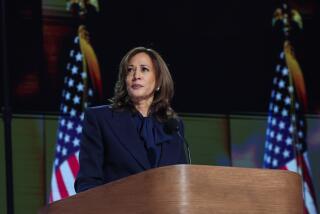Prop. 8 trial video barred -- for now
- Share via
Reporting from Los Angeles and Washington — The camera-shy justices of the U.S. Supreme Court on Monday barred video coverage of California’s Proposition 8 trial, at least for now, apparently concerned that witnesses opposed to same-sex marriage could be harassed if shown on YouTube.
It was the second time in three months that the high court had intervened on behalf of defenders of “traditional marriage.” In October, the court issued an emergency order to prevent Washington state officials from posting online the names of 138,000 citizens who had signed petitions seeking to overturn a law giving gays and lesbians equal benefits.
The justices’ order expires Wednesday at 1 p.m. PST, and they did not make clear what further action would be taken. The Proposition 8 trial began Monday and is expected to last three weeks.
Although they did not make their reasoning clear, the order could reflect a deep-seated reluctance to permit TV coverage of federal court trials. The justices still cite O.J. Simpson’s controversial 1995 murder trial in Los Angeles when the topic of cameras in court arises.
The federal judiciary had a policy of barring broadcast coverage of all trial courts. But last month, the independent-minded 9th Circuit Court of Appeals announced that it would experiment with a “limited use” of cameras in its trial courts. For several years, the 9th Circuit has permitted TV coverage of some high-profile appeals.
Citing the circuit’s new order, U.S. District Judge Vaughn R. Walker in San Francisco ruled Wednesday to permit some video coverage of the trial. He said YouTube.com could stream video of the proceedings at the end of each day. He also allowed real-time broadcasts at federal courthouses in San Francisco; Pasadena; Seattle; Portland, Ore.; and Brooklyn, N.Y.
Walker’s decision was welcomed by media groups and lawyers challenging Proposition 8. They said millions of Californians and others across the country were intensely interested in the trial.
Conservative bloggers denounced the move. “Judge Walker seems intent on orchestrating a show trial,” said Edward Whelan, president of the Ethics and Public Policy Center in Washington, D.C.
On Saturday, attorney Charles J. Cooper, a Reagan administration lawyer who is leading the defense of Proposition 8, filed an emergency appeal with the high court in Washington. He argued that Walker had flouted federal rules by opening the trial to video coverage. And he insisted his witnesses could be harassed or intimidated if their testimony were aired over the Internet.
In response, Theodore Olson, another Reagan administration veteran who is leading the challenge to Proposition 8, urged justices to steer clear of the dispute. He noted that Cooper and his witnesses had stepped forward to appear at the trial.
Usually, the high court is wary of intervening in a pending case and by rule does so only when there is a threat of “irreparable harm.” Apparently persuaded that the witnesses faced potential harm, the high court issued a brief order overruling Walker and temporarily barring transmission of the proceedings beyond the courthouse. The unsigned order also blocks “real-time streaming” of the proceedings to other courthouses.
Attached to the order was a lone dissent from Justice Stephen G. Breyer, a native of San Francisco. “In my view, the court’s standard for granting a stay is not met” because the lawyers did not show “a likelihood of ‘irreparable harm,’ ” he wrote.
Ninth Circuit Chief Judge Alex Kozinski defended Walker’s decision to open the courts to some video coverage.
“Like it or not, we are now well into the 21st century, and it is up to those of us who lead the federal judiciary to adopt policies that are consistent with the spirit of the times and the advantages afforded us by new technology. If we do not, Congress will do it for us,” Kozinski said in a letter to court officials in Washington on Sunday.
Some legal experts saw this as the latest dispute between the courts.
“It’s obviously a disagreement between the 9th Circuit and the Supreme Court on bringing television or live video into a federal courtroom,” said Jesse Choper, a constitutional law scholar at UC Berkeley. “We all have superiors, and even though we may act reasonably, sometimes the people who are your superiors say, ‘No, not while you are working for me.’ It’s just that simple. They disagreed, and the Supreme Court has the final word.”
At the 9th Circuit courthouse in Pasadena, where two large flat-screen televisions stood on the plaintiffs’ and defendants’ tables in Courtroom 3, a small group of gay-rights advocates gathered to hear the disappointing news that they would not be watching the trial.
Lynette Sperber of Sherman Oaks, who had driven to the courthouse with her gay son’s longtime partner, was distressed by the news.
“This is so disrespectful, deterring what others can see and learn about this case,” said Sperber, 66. “This is so beyond my own child. It’s about all these people who have rights just like the rest of us but are being denied.”
More to Read
Get the L.A. Times Politics newsletter
Deeply reported insights into legislation, politics and policy from Sacramento, Washington and beyond. In your inbox twice per week.
You may occasionally receive promotional content from the Los Angeles Times.












